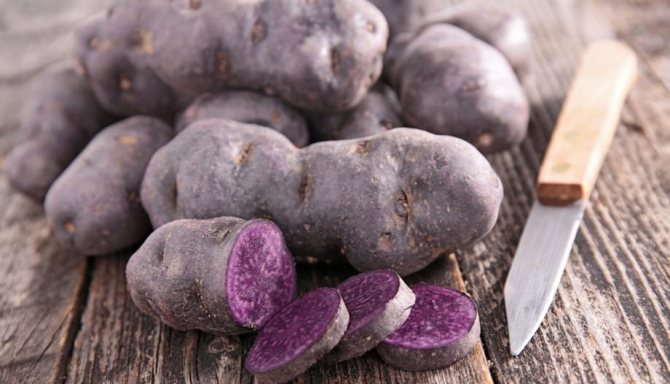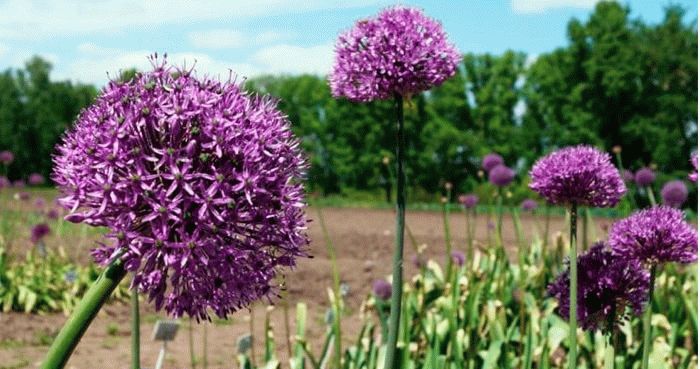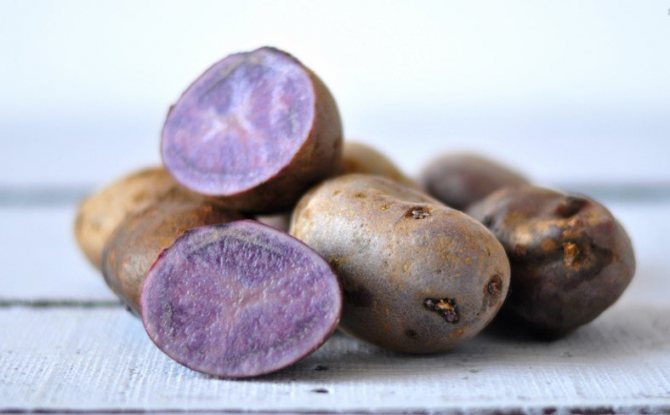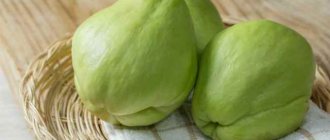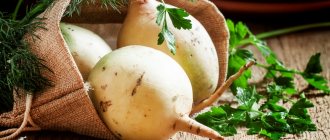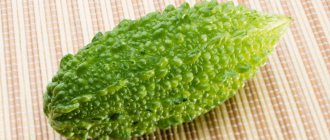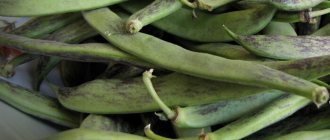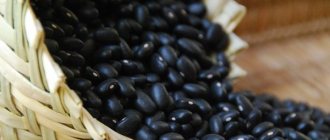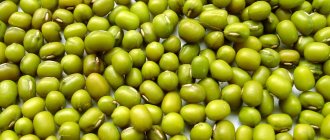Not so long ago an exotic vegetable appeared on store shelves - purple potatoes. At first, consumers were wary of it, but when the beneficial properties became known, the situation immediately changed. In addition the exotic color of the pulp allows chefs to create culinary masterpieces, distinguished by their original appearance. True, so far in our country this type of potato is not grown on an industrial scale, but for your own summer cottage, you can easily order seed in an online store.
Who is blue potato not good for?
Not so long ago an exotic vegetable appeared on store shelves - purple potatoes. At first, consumers were wary of it, but when the beneficial properties became known, the situation immediately changed. In addition, the exotic color of the pulp allows chefs to create culinary masterpieces with an original appearance.
A characteristic feature of this potato is considered not only the exotic color of the skin, but also the pulp. In this case, shades range from pale pink to deep purple. This unusual plant was obtained without the use of genetic modification methods: specialists used exclusively methods of classical selection. We crossed the potatoes familiar to us with its wild relative from South America.
Purple potato varieties include those that have an intense color not only of the peel, but also of the pulp.
Common differences between varieties with purple flesh include:
- tubers are oblong;
- the pulp does not lose its color even after heat treatment;
- there are a large number of useful trace elements that enhance immunity;
- keeps very well thanks to its thick skin.
After cooking, the pulp has a characteristic nutty flavor, which also favorably distinguishes these varieties and expands the possibilities of use in cooking.
Breeders are seriously carried away by breeding varieties with purple pulp, so now there are already quite a few of them. But domestic gardeners very often call this variety much simpler: blue potatoes. However, the essence does not change from this.
Purple-fleshed potatoes are still in the breeding stage, but already now you can purchase some varieties with different color intensities for your summer cottage. The most popular are:
- French purple truffle;
- Black woman;
- Chinese truffle;
- Vitelotte;
- Gourmet;
- Russian black.
It is not yet necessary to speak about volumes sufficient for industrial cultivation, however, stores are happy to present to their customers these varieties for cultivation in summer cottages.
Planting is carried out in two ways: traditional (tubers) and seeds. For the second option, you must first germinate the seeds, then grow seedlings at home, and then transplant them into open ground. Seeds are planted in April, and seedlings are transplanted into open ground no earlier than in mid-May.
Correctly sprouted purple potato planting material will ensure fast, uniform emergence and early tuber set
When planting tubers, the planting period is the same as for ordinary potatoes.
Soil preparation
They try to choose a light soil for planting purple potatoes. Oxygen should easily penetrate into it and excess moisture should not stagnate. An excellent option would be neutral sandy loam, as well as floodplain and sod-podzolic soils. Before the onset of the first frost, a rough primary digging of the selected area is carried out. During frosts, the larvae of pests that were in the turned-out ground will die.
The area for colored potatoes in the fall should be dug up with the introduction of potash fertilizers and superphosphate
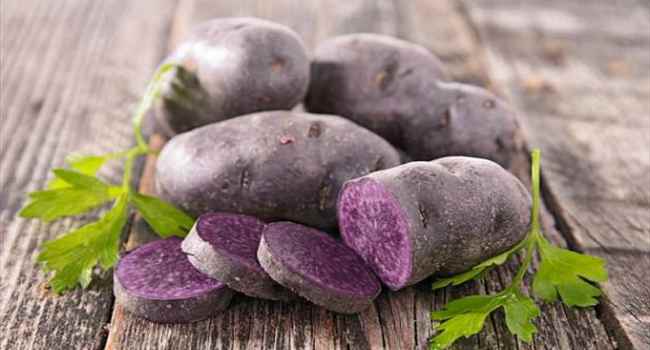
With the onset of warmth, when the minimum soil temperature reaches 5 ° C, planting begins. A repeated digging of the soil is preliminarily done, holes are prepared with the addition of wood ash. The distance between the rows should be at least half a meter, and between the holes it is kept at the level of 30 centimeters. Planting depth reaches 10 centimeters.
Planting and leaving
If the soil in the selected area is dry, then watering should be carried out at least three times: immediately after germination, during flowering and immediately after it. In the absence of rain, plants should be watered at least once a week. If there is a lot of moisture, then fungal diseases will develop, and if there is a lack of moisture, plantings may dry out.
After emergence of purple potatoes, it must be weeded regularly and removed. When a crust appears on the soil, loosen it. The beds are regularly treated with drugs against the Colorado potato beetle, late blight and other common pests and diseases.
Loosening the soil and hilling potato beds
So far, purple potatoes are classified as delicacies. But thanks to the hard work of domestic breeders, it is quite possible that soon it will become available to any category of the population, as it benefits the human body. This would be great, since the beneficial properties of this product make us seriously think about the industrial scale of growing colored potatoes in our country.
The first time you see a dish made of purple potatoes, you might think that it is made from blueberries - it has such a bright purple color. And when tasting, the taste of native white potatoes is immediately remembered. What is this new vegetable that boggles the imagination and taste buds?
The purple potato takes its roots literally and figuratively from the countries of South America. The Indians have been growing it since ancient times, and it was brought to Russia recently. But this does not prevent the overseas dark-skinned woman from winning the hearts and stomachs of our compatriots. From the article you will learn how this type of potato is useful, whether there is harm to the body, and also how it can be used in cooking and medicine.
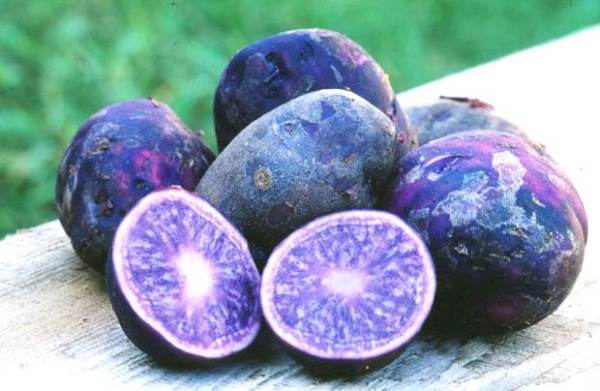

In addition to its bright and original appearance, purple potatoes have other useful properties.
Energy value per 100 grams of product - 72 kcal, protein content - 2 g, fat - 0.4 g, carbohydrates - 16 g.
Purple tubers are packed with vitamins. These are ascorbic, folic, pantothenic acid, beta-kerotin, vitamins of group B (B1, B2, B6), E, PP, A.
The amount of trace elements exceeds all expectations: iron, iodine, aluminum, fluorine, zinc and many others.
There are also a lot of macronutrients: calcium, potassium, magnesium, sodium, fluorine - everything that is needed for the normal functioning of the body. For the complete assimilation of vitamins, other vegetables must be added to the potatoes. Then the diet will be rich and complete.
To introduce purple potatoes on the menu, you need to understand its pros and cons, benefits and harms. A bowl of scales with the beneficial properties of a blue root vegetable clearly outweighs:
- Due to the sufficient amount of ascorbic acid, purple potatoes have a beneficial effect on the immune system.Taking care of your immune system is especially important in the fall and winter.
- The content of dietary fiber ensures good digestion, stool problems disappear, the intestines work like a clock. And starch envelops the walls of the stomach, protecting it from damage. Flatulence is eliminated.
- Having cleansing properties, potatoes put in order the cardiovascular system of the body. The appearance of blood clots in the vessels is neutralized, the risk of a heart attack is minimized.
- The beneficial substances of the tubers help fight poor vision and ophthalmic diseases.
- The presence of antioxidants has a slowing down effect on the aging process.
- Folic acid in the vegetable reduces the risk of anemia, increases hemoglobin. This makes purple potatoes a must-have item on the pregnancy menu.
- People suffering from high blood pressure need this vegetable because it reduces it.
We suggest that you familiarize yourself with: The use of cranberries: benefits and harms to human health
Potatoes can harm people:
- having low blood pressure;
- weight watchers.
Potatoes are rightfully one of the most versatile vegetables in the world. Hundreds of its varieties are known and cultivated, nevertheless, this vegetable continues to amaze gardeners. Purple potatoes, or blue French truffle for the full name, are considered a delicacy and also have many health benefits.
There is no exact information about the origin of this species. Presumably, this is one of the varieties of potatoes that has long been common in the countries of South America. The result of long-term selection work and careful selection was the breeding of new fixed hybrids with the color of the pulp of tubers from lilac to dark purple.
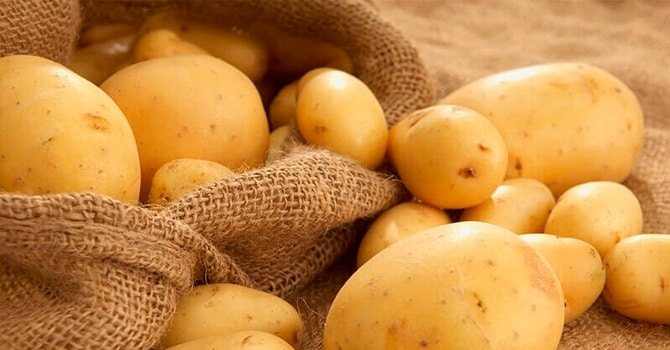

The color of purple potatoes is influenced by the percentage of anthocyanins - colored plant glycosides. Elongated tubers are small in size and weight - no more than 10 cm and 70 g, respectively. Most varieties are late ripening, but there are both medium and super early ones. The higher this indicator, the denser the skin of the tubers and the better keeping quality.
Cooking does not change the color of the dishes in the majority of varieties, but some may, after heat exposure, lose their brightness and purity of color.
The following descriptions and characteristics of the most famous and tested varieties that are popular all over the world will help gardeners who want to grow such a "blue miracle" on their plots to make a choice and make a choice:
- Vitelot (Vitelotte, also has the names Negritanka and French truffle) is a late variety with a dark purple rind. The ripening period is up to 110 days, it is stored for a long time without loss. It has a characteristic rich nutty flavor and does not change color during heat cooking. Tuber weight - 70-100 g;
- All blue (an exact translation of the original name All Blue) is medium early, has large tubers - up to 200 g in weight. A characteristic feature of the variety is a light strip between the pulp and skin. Due to its excellent taste and dietary properties, it is rapidly gaining popularity in our country;
- Explosion - got its name due to super-early fruiting (up to 65 days). The flesh and rind are even dark purple in color. A distinctive characteristic is high resistance to diseases. It is poorly stored, but good for quick use in any dishes, including raw in salads;
- Lilac is a mid-season variety of Russian selection. Despite the small mass of fruits (up to 80 g) and average yield, it has good keeping quality and resistance to diseases (cancer and scab). Having the taste of almonds, it is considered a valuable dietary product;
- Peruvian purple (Purple Peruvian) - bred in Peru.Late ripening variety with medium yield. As you can see in the picture, Peruvian potatoes are small in size, but their amazing taste - walnut and hazelnuts at the same time - arouses consumer interest.
Preparing the landing site
The soil for planting potatoes should be light and fertile. She must be well supplied with oxygen. The most optimal option is neutral sandy loam, sod-podzolic soils. Before the first frosts, it is necessary to carry out the initial digging of the earth. During the onset of frost, the pests that were in the dug earth will die. Potatoes can be planted at a soil temperature of at least 5 degrees. Before this, it is necessary to re-dig the soil, prepare the holes in which the wood has already been filled up. The optimal distance between the rows should be about 50 cm, and between the holes it should be around 30 cm.
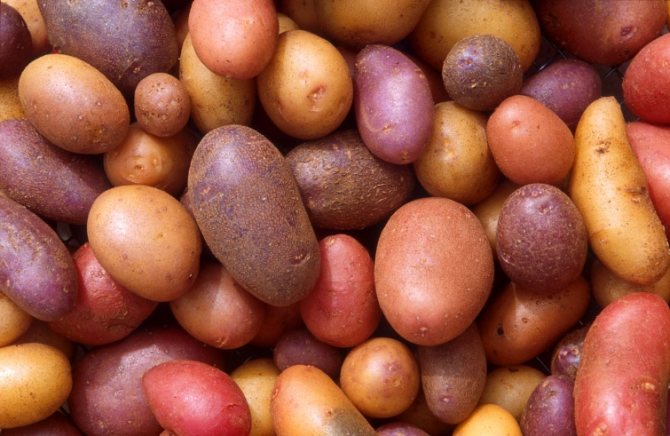

Purple potatoes harm and contraindications
- Water (about 80%);
- Vegetable proteins;
- Fats;
- Fatty acids represented by myristic, palmitic, stearic, linoleic, oleic (omega-9), palmitoleic, linolenic and omega-6;
- Carbohydrates (digestible among them - dextrin, starch, sugars, mono- and disaccharides, fructose, sucrose, glucose or dextrose);
- Essential amino acids (valine, arginine, histidine, leucine, isoleucine, methionine, lysine, tryptophan, threonine, tyrosine, phenylalanine);
- Nonessential amino acids (aspartic and glutamic acids, alanine, glycine, tyrosine, proline, serine, uisteine);
- Organic acids;
- Dietary fiber (fiber);
- Ash products;
- Retinol (or vitamin a);
- Provitamin a (beta-carotene);
- B vitamins (thiamine, riboflavin, pyridoxine, pantothenic and folic acids, niacin);
- Phylloquinone (vitamin K);
- Ascorbic acid (vitamin C);
- Alpha-tocopherol (vitamin E);
- Vitamin N (biotin);
- Macronutrients in the form of calcium, potassium, magnesium, sodium, phosphorus, sulfur and chlorine;
- Minerals represented by boron, iron, aluminum, lithium, cobalt, iodine, copper, manganese, molybdenum, nickel, fluorine, rubidium, selenium, zinc and chromium.
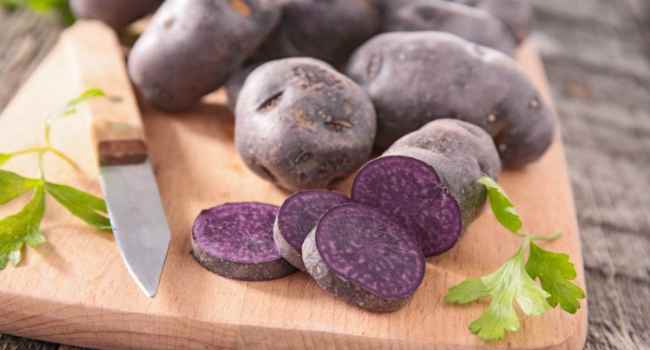

15 grams of carbohydrates;
1 gram of fiber
2 grams of protein.
It contains a lot of potassium, which brings certain benefits to people suffering from high blood pressure. Plus, more antioxidants.
Research conducted by the USDA has shown that 6 golf ball-sized tubers eaten every day for a month can reduce blood pressure by an average of 4 percent. Agree, this is not so little.
In addition, thanks to all the same antioxidants, it helps to strengthen the immune system, can prevent and reduce the risk of heart disease and oncology.
In addition to potassium, which helps regulate cellular fluid, and antioxidants, blue potatoes contain ample amounts of vitamin C. They are low in fat and free of cholesterol.
Even if not by much, but the content of starchy substances in it is still less than that of ordinary potatoes. This fact should be noticed by weight watchers and dieters.
Due to its characteristics, it is blue potatoes (trace elements do not disappear after freezing or prolonged heat treatment) that can boast of maximum benefits for the human body.
As a result, eating purple potatoes helps:
- Bind toxins and toxins;
- Rather, remove feces;
- Normalize intestinal motility;
- Remove inflammation of the mucous membranes of the digestive system;
- Prevent stool disturbance;
- Prevent constipation and diarrhea;
- Relieve the manifestations of flatulence and associated abdominal pain;
- Protect the gastric mucosa (potatoes seem to envelop it);
- Reduce body weight (by cleansing the body of toxins and toxins);
- Accelerate metabolic processes;
- Improve eyesight;
- Prevent the development of glaucoma and cataracts;
- Remove the risks of myopia;
- Reduce fatigue and stress when working at a computer monitor;
- Clear the walls of blood vessels from various negative deposits;
- Prevent blood clots;
- Remove "bad" cholesterol;
- Prevent the formation of cholesterol plaques;
- Reduce the risk of myocardial infarction;
- Prevent the development of atherosclerosis;
- Lower high blood pressure;
- Strengthen the vascular walls;
- Improve general vascular microcirculation and blood flow;
- Restore heart rate;
- Improve the work of the heart muscle;
- Prevent stroke;
- Accelerate and improve the absorption of iron by the body;
- Prevent the appearance of anemia (by promoting the early formation of red blood cells);
- Increase the activity of the immune system in the fight against viruses (that is, strengthen the immune system);
- Rejuvenate the body (thanks to natural antioxidants, polyphenols);
- Protect cells from the negative effects of free radicals (that is, cancer is prevented);
- Remove salts that are deposited in the joints;
- Reduce fever
- Remove the manifestations of tuberculosis and prevent the appearance of this disease.
Cooking classifies blue potatoes as an unusual category, but uses it as a common vegetable. Purple potatoes have a medium starchy texture, making them versatile and suitable for most potato recipes.
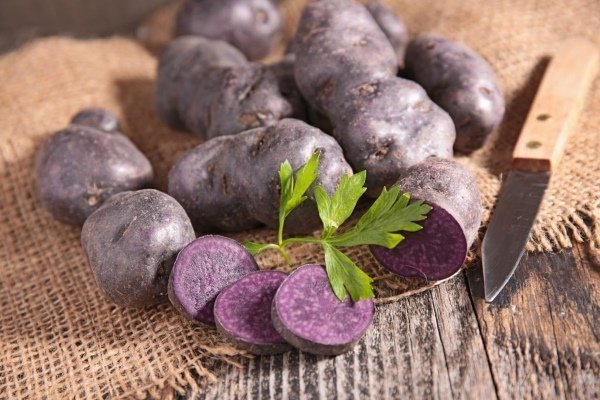

Therefore, such potatoes with a nutty flavor are boiled, stewed, baked, made casseroles and even potato pancakes from them. And all this happens without the loss of the available minerals and vitamins.
Use in salads will add brightness to the boring look of the dish, it retains its shape when baked and is well mashed when making puree.
To maximize nutrients and minimize calories, simply boil it, puree it, or bake it instead of frying it.
It is enough to boil the tubers (preferably with the peel), sprinkle with olive oil and sprinkle with finely chopped onions and crushed garlic.
We suggest that you familiarize yourself with: The benefits and harms of parsnips for health, contraindications, video
It will be delicious baked with paprika and cut into slices, lightly seasoned with salt.
Here are some more ideas on how to make purple potatoes.
Combine the diced potatoes with the shallots. Season with a little pepper and olive oil. Place in the oven. When it's half cooked, remove the lid, add the leeks and cook through. Sprinkle the finished dish with rosemary, parsley, dill.
For mashed potatoes, boil and mash. Use almond milk instead of butter and milk. Season the finished puree with fried garlic.
Bake whole, without peeling, in the oven or microwave, lightly drizzling with olive oil. Season the cooked potatoes with Greek yogurt, fresh onions and herbs.
For potato salad, cut into cubes. Combine mayonnaise with mustard, Greek yogurt and season salad.
Some people think that purple potatoes are not much different from the usual. On the one hand, this is a correct judgment. But the consumption of such a food product should also be taken with caution. After all, blue potatoes, despite the lower starch content, are not recommended:
- Pregnant women (bloating often occurs);
- Elderly people and children (there are not enough enzymes for digestion);
- With the fact of obesity (due to increased calorie content, high carbohydrate content, promoting the accumulation of fats in the body, slowing down the processes of cleansing the latter from slagging);
- In the presence of diabetes mellitus (such a potato contains a large amount of mono- and disaccharides, sucrose, fructose, glucose);
- In the presence of constipation (in this case, you can use only puree to avoid irritation of the intestinal mucosa and provoking exacerbations);
- With gastritis (fried and baked potatoes are completely prohibited, only mashed potatoes and boiled potatoes in soup are allowed);
- With low blood pressure or hypotension (due to the product's ability to lower blood pressure).
Here is such an unusual purple potato so far for many. In addition to its nutritional value, health benefits, it can give your meals a vibrant color and brighten the table.
What is purple potato, how is it useful, learn from the video show "Dacha TV"
Purple potatoes deserve attention not only because of their unusual appearance and bright color. It has a lot of useful and healing properties. For example, if you prepare a dish from it in any way, you can easily lower blood pressure in the human body. At the same time, these potatoes can be harmful to people suffering from low blood pressure, should be avoided in the menu of colored potatoes.
In addition to antioxidants, purple tubers with unusual coloration contain a large amount of vitamin C
Due to the presence of antioxidants, purple potatoes are able to slow down the aging process. It contains a large amount of vitamins C, E and carotenoids. The product is not genetically modified, and its unusual color is the result of crossing with wild African and equatorial varieties.
Regular consumption of colored potatoes improves vision and strengthens the walls of blood vessels. This reduces the risk of atherosclerosis. It also reduces the risk of developing certain types of cancer.
15 grams of carbohydrates;
1 gram of fiber
Research conducted by the USDA has shown that 6 golf ball-sized tubers eaten every day for a month can reduce blood pressure by an average of 4 percent. Agree, this is not so little.
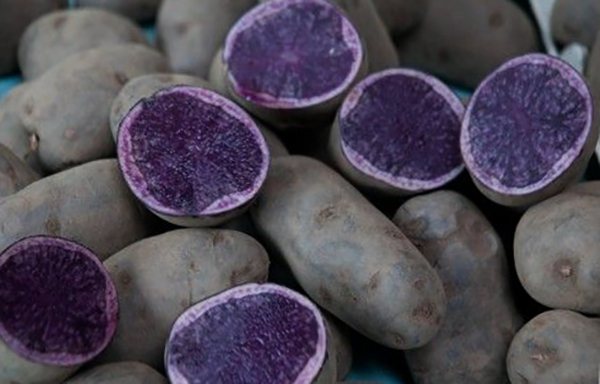

Most people associate potatoes with not very healthy food, after which there is a gradual increase in body weight. In fact this is not true. Especially when it comes to blue potatoes, which in recent years have begun to appear on the shelves of our stores. They can provide health benefits.
Potatoes should be eaten with caution:
- Diabetics. Quite high levels of starch and sugars will increase blood sugar.
- Hypotonic. The product lowers blood pressure, it is useless for people who already have it low.
- Obese. Purple potatoes cannot be called dietary, so if you are obese, it is better to give up the vegetable, or minimize its amount.
You cannot get better from this product if you do not eat it together with fatty and flour additives. The beneficial properties of purple potatoes are the basis of the fact that in many countries it is considered a particularly valuable, dietary product.
Nevertheless, an excessive enthusiasm for blue varieties can in some cases bring not only benefits, but also harm.
Colored varieties contain much more than ordinary ones, micro- and macroelements, which do not decrease even after prolonged heat treatment. This is the reason for the benefits of purple potatoes. In frozen and canned (pickled, salted) form, the vegetable retains its useful qualities. It is recommended in many children's diets.
The main medicinal properties of the product:
- lowers blood pressure, and so much that it is not recommended for hypotensive patients for constant use;
- Anthocyanins, which give the culture a recognizable color, are also powerful antioxidants.They stimulate metabolic processes at the cellular level, enhance immunity, neutralize the harmful effects of carcinogenic substances and radio emissions on the human body, help it suppress oncological neoplasms, improve vision and slow down the aging process;
- contains a large amount of vitamins, especially important for the human body, C and E, as well as carotenoids that affect the synthesis of vitamin A and regulate the endocrine system;
- The beneficial substances contained in blue varieties make the walls of blood vessels more elastic, which reduces the risk of developing atherosclerosis.
Benefit
To introduce purple potatoes on the menu, you need to understand its pros and cons, benefits and harms. The bowl of scales with the beneficial properties of the blue root vegetable clearly outweighs:
- Due to the sufficient amount of ascorbic acid, purple potatoes have a beneficial effect on the immune system. Taking care of your immune system is especially important in the fall and winter.
- The content of dietary fiber ensures good digestion, stool problems disappear, the intestines work like a clock. And starch envelops the walls of the stomach, protecting it from damage. Flatulence is eliminated.
- Having cleansing properties, potatoes put in order the cardiovascular system of the body. The appearance of blood clots in the vessels is neutralized, the risk of a heart attack is minimized.
- The beneficial substances of the tubers help fight poor vision and ophthalmic diseases.
- The presence of antioxidants has a slowing down effect on the aging process.
- Folic acid in the vegetable reduces the risk of anemia, increases hemoglobin. This makes purple potatoes a must-have item on the pregnancy menu.
- People suffering from high blood pressure need this vegetable because it reduces it.
Read also: What plums are prunes made of?
Potatoes can harm people:
- having low blood pressure;
- weight watchers.
Useful properties and application
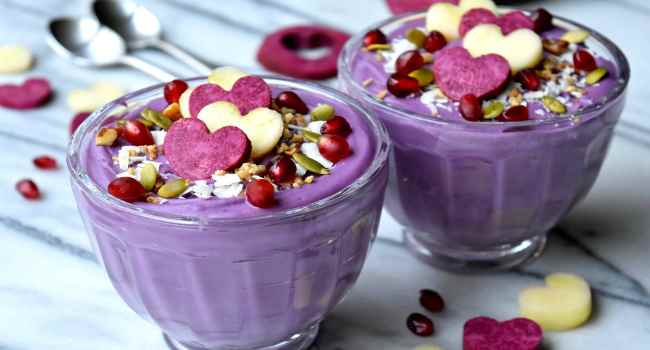

The purple variety has long been considered an original, sophisticated potato that sold at fabulous prices. It made unusual dishes with a spicy flavor of nuts.
Today, the vegetable is available to everyone, so housewives and restaurant owners actively use it in cooking. It is fried, boiled, baked. It makes excellent potato pancakes, fries, zrazy, potato pancakes, chips, salads, mashed potatoes, baked dishes (especially puff ones), soups and much more. Dumplings with purple filling look especially unusual.
But a special feature is its use in dietary nutrition, as it promotes weight loss, saturates the body with microelements, and accelerates metabolism.
Cooking features:
- It is advisable to boil this vegetable in salted water. This will keep all the nutrients in it.
- After boiling in the "uniform", the peel is removed more easily than from conventional varieties.
- The best combination is considered with beans, meat, vegetables, fish and herbs.
- In order for the potatoes to boil faster, add 1 tbsp. l. butter, and after boiling (like beets), place a saucepan under cold water, adding ice cubes.
- It is forbidden to use a blender, as the mass is converted into a paste.
- During cooking, natural dyes are released from the peeled potatoes, so the water takes on an emerald green hue. Do not let this scare you, on the contrary, you can boil soup from broth, make sauce.
- Due to the color of the water, the purple variety cannot be cooked with white potatoes and other vegetables.
- Prepares quickly, which must be taken into account.
We suggest that you familiarize yourself with: Lapis lazuli from weeds on potatoes: instructions for use, reviews
Some recipes:
- Salad. Grate boiled potatoes, add herbs and garlic, salt and pepper, season with mayonnaise. Looks great as a spread on a sandwich.
- Bake whole tubers, peel, cut in half.Place on a plate, sprinkled with Greek yogurt. Sprinkle greens on top.
- Crisps. Peel raw tubers, cut into slices. Dry with paper towels. Puncture with a fork. Sprinkle with salt. Place the chips in a metal sieve, dip in boiling vegetable oil. Place on a towel until fat drips.
- Boil standard noodle soup with purple potatoes (broth will be greenish). At the end of cooking, add grated processed cheese and herbs.
- Casserole. Boil the tubers, crush. Add a raw egg and a little warm cream. Put the fried mushrooms, onions and carrots on the bottom of the pan, purple puree on top. Then repeat 2-3 more of these layers. Place herbs and cheese on top.
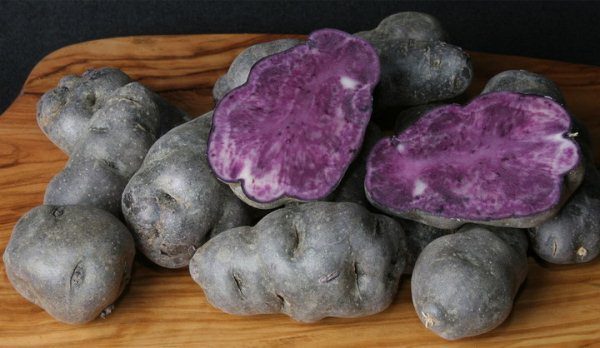

There are practically no contraindications for purple potatoes, but it is necessary to limit its consumption in such cases:
- low blood pressure (hypotension);
- individual intolerance;
- constipation;
- a reduced level of acidity of gastric juice;
- obesity of the last stage.
It is necessary to eat such a vegetable with the following pathologies:
- hypertension (high blood pressure);
- diabetes;
- weakened immunity;
- intoxication;
- some diseases of the heart and circulatory system;
- inflammatory processes in the body.
Useful properties of purple potatoes:
- Lowering blood pressure.
- Inhibition of aging processes (due to the shock amount of antioxidants).
- Strengthening the immune system, which, in turn, prevents the development of colds, infectious and other diseases.
- Water balance normalization.
- Improving the functionality of the endocrine system.
- Sharpening of vision.
- Strengthening the walls of the circulatory system.
- Decrease in blood sugar levels.
- Elimination of flatulence, acceleration of the digestion process.
- Decrease in acidity with gastritis.
- Reducing inflammation in the internal organs.
- Maintaining the work of the myocardium.
- Irritability is eliminated.
- Sleep is normalized.
What harm can be:
- If you eat potatoes with contraindications, the diseases become aggravated: with hypotension, a hypotonic crisis occurs, etc.
- With potato abuse (overeating): flatulence, heaviness in the stomach, constipation, bloating.
- In case of individual intolerance: an allergic reaction occurs.
In practice, the same dishes are prepared from purple potatoes as from white or cream ones. Moreover, they differ in their original appearance.
Colored potatoes are used in dietary nutrition, since they contain not only a huge amount of vitamins and microelements, but also with a high level of starch content does not lead to obesity. This is achieved due to the metabolic activity of other substances.
Growing features
Planting purple potatoes is possible with tubers and seeds:
- with the traditional version (tubers), the sowing time is the same as for ordinary species;
- in the second case, seedlings are grown from the seeds of purple potatoes, which are planted in open ground after 1-1.5 months.
The soil is chosen light, and the site is light, sunny: purple potatoes need constant access of air and light. With timely traditional processing methods, it will thank you with a high and valuable harvest.
A source
Unlike regular potatoes, purple vegetable varieties are more whimsical and need special care. Planting is carried out in mid-April - with tubers or seeds, but not with eyes. It is important to consider that the purple vegetable is extremely susceptible to disease, as well as some pests, such as the Colorado potato beetle. A suitable soil for planting a crop is loam. The rest of the agronomic measures are similar to white potatoes.
A bit of history
Blue potatoes are native to Peru and Chile. After the conquest of the American continent by the Spanish conquistadors, he, along with other types of potatoes, gradually settled in Europe.Initially, the culture was grown for royal tables, but over time it has become an integral part of the daily diet of all Europeans. The blue (purple) variety called Vitelotte was originally grown primarily in Picardy in France.
The first mention of this variety dates back to the beginning of the 19th century. In 1812-1817. it has been included in the list of cultures that can be bought in Les Halles markets in Paris. A. Dumas mentions it in his famous book "The Grand dictionnaire de cuisine", describing it as the most delicious variety of potatoes.
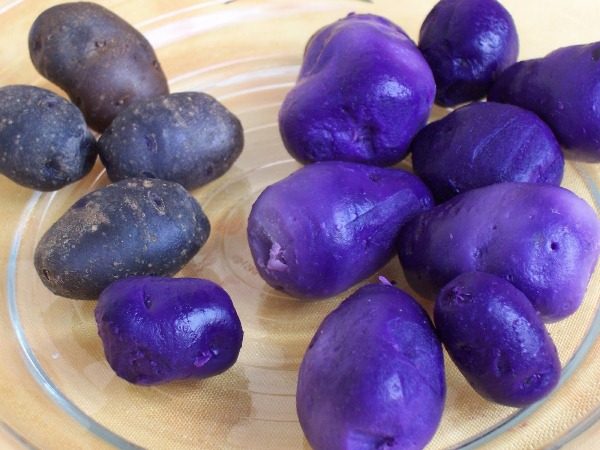

There are several types of blue potatoes including Purple Majesty, Purple Viking, Purple Peruvian.
Why is it blue?
Anthocyanins, natural dyes, are responsible for the unusual color of the root crop. In the original varieties, the inside of the potato was colored only partially, in the form of arches, stripes, rays. The solid blue color of the flesh was rather an exception.
Why is it blue?
Varieties
Purple potatoes are still being bred, but some varieties can already be distinguished:
- Vitelot.
- Lilac.
- Explosion.
- Peruvian purple.
- Exotic.
- Santarka.
- Tiras and others.
Due to its appearance and taste, this potato is gaining more and more popularity, so breeding development will continue. Nowadays, purple potatoes are perceived as an overseas miracle, they are rarely found on the shelves of ordinary stores or supermarkets. But breeders see great potential in it, so there is a high probability that it will soon begin to be grown on a larger scale.
If you find an error, please select a piece of text and press Ctrl + Enter.
We tried to write the best article. If you liked it, please share it with your friends or leave your comment below. Thank you! Excellent article 10
Purple power or health effects
Blue potatoes are a good source of many minerals (potassium, magnesium, iron, calcium) and vitamins (A, B1, B2, B6, C). In addition to carbohydrates, the root vegetable also contains a certain amount of fiber and protein. More interesting compounds are the aforementioned anthocyanins, carotenoids, phenolic and chlorogenic acids.
According to a scientific study conducted in Scranton, Pennsylvania, people who ate 6-8 small potatoes for lunch or dinner for 1 month suffered much less from high blood pressure and excess body weight. Another study found that regular consumption of this strain reduced levels of cancer markers associated with colon cancer.
The results of the study, presented at the American Chemical Society's National Congress in Denver, Colorado, showed that consumption of blue potatoes contributed to lower blood pressure in study participants (compared to participants who did not eat colored root vegetables). This effect on pressure is associated with the positive effect of potatoes on capillaries and blood vessels.
Blue potatoes have a high concentration of an important phytochemical, chlorogenic acid. Its effect on pressure has been proven previously.
Other effects
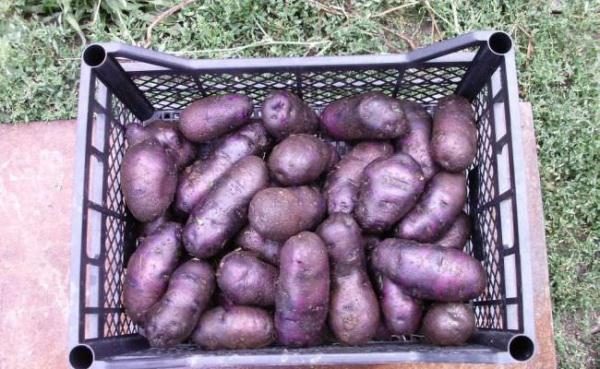

As with any fruit or vegetable, the rich, dark color of blue potatoes is indicative of their high nutritional value.
- Rich in strong antioxidants, anthocyanins. Anthocyanins, a flavonoid, are best known for their ability to strengthen the immune system and fight cancer. These antioxidants are also found in blueberries and pomegranates.
- Anthocyanins are also beneficial for health due to their ability to protect the integrity and structure of DNA and support the production of cytokines necessary for the normal functioning of the immune system.
- Powerful antioxidants also have anti-inflammatory properties, helping to protect capillary health and integrity by strengthening capillary membranes.
- They also play an important role in regulating estrogen activity, which helps reduce the risk of hormone-related diseases.
- The blue potato variety does not burden the digestive system, which is why it is often recommended for people with stomach ulcers or those with food poisoning.
- The root vegetable has a diuretic effect. But, on the other hand, when consuming it, caution is needed for people who have been advised by a doctor to reduce potassium intake due to kidney problems.
- On the contrary, potassium is suitable for people with high blood pressure problems. Cucuamine is also useful for them, represented in a purple root vegetable in a relatively large amount (the largest percentage is found in boiled potatoes, the smallest amount remains after frying).
- Carbohydrates also have a positive effect on the body by providing energy to the body. Thanks to them, a person is saturated for a long time. In addition, due to the gradual assimilation of starch, the sugar level is maintained at the proper level.
And a little more about the beneficial properties. Blue Potato supports the treatment of the following health problems:
- Colds.
- Diseases of the paranasal cavities.
- Rheumatism, rheumatoid arthritis.
- Gout.
- Stomach problems.
- Heartburn.
- Swelling.
- High cholesterol.
- Hyperacidity.
- Stomach ulcer.
- Gastritis.
Blue potatoes are a good source of many minerals (potassium, magnesium, iron, calcium) and vitamins (A, B1, B2, B6, C). In addition to carbohydrates, the root vegetable also contains a certain amount of fiber and protein. More interesting compounds are the aforementioned anthocyanins, carotenoids, phenolic and chlorogenic acids.
Tags: harm, potatoes, benefits, blue
About
«Previous post
In folk medicine
Purple potatoes help with many troubles... Traditional healers recommend eating it with high acidity and gastritis, high blood pressure, constipation, myopia and cataracts, for the prevention of cardiovascular diseases. For allergic rashes, burns, age spots, lotions from raw purple potatoes help. It is also great for making nourishing face masks, improving skin tone and condition.
The mask of boiled potatoes with sour cream is popular with women over 40 years old. For swelling and dark circles under the eyes, compresses from a vegetable are popularly used. You can put raw cut slices or compresses (grated raw potatoes wrapped in cheesecloth) under your eyes.
For colds and throat infections in folk medicine, potato broth is used. The patient breathes in vapors of boiled vegetables, and improvements are not long in coming.
Important!
The juice of raw purple potatoes does an excellent job of cleansing the body, removes all toxins.

